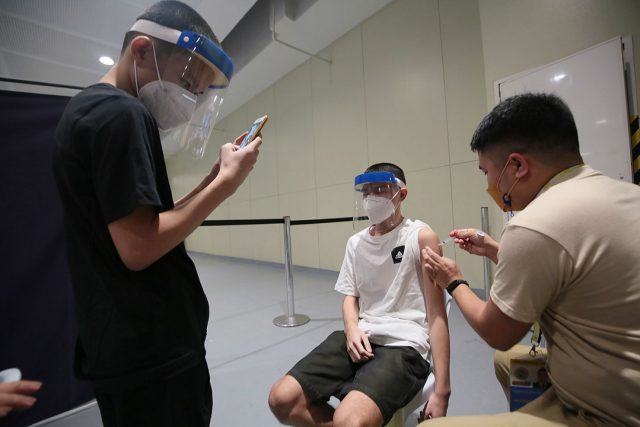
By Kyle Aristophere T. Atienza, Reporter
and Norman P. Aquino, Special Reports Editor
PAULINE F. CONVOCAR, a Filipino emergency physician, had to turn down patients upon patients when a coronavirus surge spurred by a more contagious Delta variant nearly exhausted the country’s health system in the past quarter.
Now, she’s worried of another wave of infections from the Omicron variant — scientists on Friday said this one appeared to spread more than twice as quickly as Delta — just as the Philippines relaxed lockdowns amid decreasing cases.
“This new variant gives us that feeling of uncertainty again because we do not yet fully know how it behaves,” Ms. Convocar, who heads the Philippine College of Emergency Medicine’s advocacy section, said by telephone. “It poses another uncertainty.”
 Scientists around the world are racing to understand how widespread Omicron is and how severe a threat it may pose. For one, it’s still unclear whether or to what extent the virus first detected in South Africa may resist existing vaccines.
Scientists around the world are racing to understand how widespread Omicron is and how severe a threat it may pose. For one, it’s still unclear whether or to what extent the virus first detected in South Africa may resist existing vaccines.
In the United States, a hunt for the variant started last week when South African researchers announced Omicron’s array of worrisome mutations. The search has intensified in recent days, with at least 12 states identifying cases, the New York Times reported on Sunday.
At the Philippine Genome Center (PGC), medical experts are racing to screen samples from international travelers to see if Omicron has arrived.
They have yet to detect the virus after screening 18,000 samples, PGC Executive Director Cynthia P. Saloma told a televised news briefing at the weekend, but “it is possible that it has entered our borders. We are on the lookout for that.”
Philippine shares slightly gained on Friday as investors turned a bit optimistic after Wall Street’s rally, but trading remained sluggish amid lingering concerns over the pandemic.
Wall Street’s major indexes closed lower on Friday as investors grappled with uncertainty around the Omicron coronavirus variant.
As part of easing quarantine rules, the Philippine government last month started allowing children in Manila, the capital and nearby cities in malls after they were holed up in their houses for the past 20 months.
Now, all parts of the country are under Alert Level 2, the second most relaxed lockdown level.
As the Omicron variant came to light, the government said it would allow fully vaccinated foreigners to enter the country starting Dec. 1, even as it banned flights from several African countries where the variant was present. It scrapped the plan days later.
A group of private hospitals is preparing for a potential spike in Omicron coronavirus infections. Jose Rene de Grano, president of the Private Hospitals Association of the Philippines, Inc., told ABS-CBN Teleradyo last week they are ready in case of another infection wave.
He said they have ample supply of oxygen and vacant beds amid decreasing cases in recent weeks.
The new “variant of concern” gives the world a glimpse of where the pandemic might be headed. It should also prompt the government to focus on evidence-based policies and listen to the calls of the health sector, said Joshua L. San Pedro, a medical doctor who started the Coalition for People’s Right to Health.
“Evidence-based policies should be the standard by now, almost two years into the pandemic,” he said in a Facebook Messenger chat. “Learning from other countries’ experience as well as ours, there is some semblance of what is effective and how it ought to be implemented.”
PANDEMIC GAPS
Mr. San Pedro said the government has done very little to boost health facilities and increase health staff. It has to see the gaps in its pandemic response and do something about it.
“As we saw with previous surges, every new one seems to be worse than the one before it.”
The government also can’t rest on its vaccination laurels when there are still provinces without testing laboratories, its contact tracing system remained weak and there’s growing public complacency, Mr. San Pedro said.
Many countries with much higher vaccination rates have experienced some of the worst coronavirus spikes, he added.
There’s also the problem of understaffed hospitals, said Maristela Presto-Abenojar, president of Filipino Nurses United.
The chronic nursing shortage in one of the world’s top sources of health workers has existed even before the coronavirus pandemic, she pointed out.
Local governments only have 5,656 public nurses, while the National Government has 18,994, Ms. Abenojar said, citing government data. Ideally, there should be at least one nurse in each of the country’s 42,046 villages, she added.
“In addition, there are only 30,396 nurses in 202 public hospitals working three shifts a day and/or two shifts a day for a 12-hour duty,” she said.
In 1,170 state-licensed private hospitals, there are only 34,840 nurses working three shifts a day, she added.
“For the last two years, nurses, doctors and other health workers were referred to as heroes on the frontline taking care of more than 2 million COVID-19 patients nationwide,” Ms. Abenojar said. “But they have become sacrificial lambs in this pandemic battle.”
At the heart of a major breakdown of the country’s healthcare system earlier this year, overworked and underpaid nurses and caregivers protested and threatened to quit their jobs.
“We have not heard any ambitious proposals yet to address health workforce shortage and burnout,” said Renzo R. Guinto, a doctor and associate professor of global public health at the St. Luke’s Medical Center College of Medicine. “We are still relying on health workers’ sense of volunteerism.”
He noted that as 2022 beckons with potentially more coronavirus variants emerging, the country is still largely “using the 2020 playbook for pandemic response with a largely pre-pandemic healthcare infrastructure.”
“After almost two years since the pandemic began, we are still resorting to reactive rather than anticipatory approaches,” he said in a Facebook Messenger chat.
The Philippines needs a “Marshall plan” to revitalize its public health system, Mr. Guinto said, adding that the government should invest in research and surveillance activities that will detect disease-causing pathogens “to make sure we do not become the ground zero for the next pandemic.”
“COVID-19 already revealed to us the myriad defects of our health system, and unfortunately we are not using the pandemic period to fix many of these problems,” he said.
Joey Francis Hernandez, a doctor and treasurer of the Philippine Society of Public Health Physicians, said the country needs a community-based approach instead of a heavy-handed militarist one that tries to silence critics.
People from communities must be part of public health conversations, he said in a Messenger chat. Contact tracing is also useless “if we’re not going to do anything about the data we collected.”
“With our numbers improving, contact tracing and accessible testing should be emphasized again to keep our numbers low and even lower,” he said. “However, that has to be through a stronger national push with solid, coordinated efforts from the local governments.”
Mr. Hernandez said authorities should ditch policies that are not enforceable.
In jeepneys, for example, it’s better to ensure that everyone wears a mask and hand sanitizers are provided instead of limiting their capacity by setting up plastic barriers, he pointed out.
Policy makers should heed the advice of scientists and public health experts before anyone else. “COVID response should be led by scientists and public health experts, and not generals and politicians.”
“Even if we’re tired, we’d rather take a rest and soon get back to work and try to really hold the line,” said Ms. Convocar, the emergency physician. “We are the first to stand and the last to fall. We have to be brave for the others.”
Philippines faces another infection wave as Omicron looms
Source: Bantay Radio
0 Comments